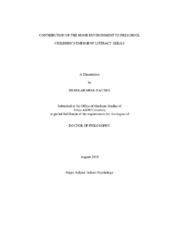| dc.description.abstract | Recent and ongoing research has demonstrated the alarming likelihood of children from low-income homes and from ethnic minorities to read at much lower reading levels than their peers. Additionally, reading ability is related to the earliest of emergent literacy skills, which can be measured in young children before they enter formal schooling. The home environment, including the available resources, support for literacy and school, and the parent-child relationship, plays an important role in promoting the development of emergent literacy skills. More research is needed, however, to inform programs and researchers about the specific relationship between the home environment and emergent literacy development.
The current study was conducted using a sample of 122 preschool children enrolled in ERF enriched preschool classrooms in one school located in a Southwestern state. The study investigated the power of three variables of the home literacy environment (HLE) (i.e., Family Reading and Writing, External Resources, and Daily Activities) to predict three emergent literacy outcomes (i.e., receptive oral language, alphabet knowledge, and name writing) using canonical correlation analysis (CCA). The study also used commonality regression analysis to examine the shared and unique variance in these emergent literacy outcomes accounted for by the variables of the HLE and the parent-child relationship. The results of the CCA did not find the variables of the HLE to have a statistically significant relationship with the emergent literacy outcomes. Missing data techniques were used to account for incomplete data, and he results were closer to obtaining statistical significance when the more advanced method of multiple imputation was used to account for missing data, with the p-value decreasing from .751 with listwise deletion to between .094 and .504 with multiple imputation. The second analysis of the study, the commonality regression analysis, did find home variables to account for unique and shared variance in the emergent literacy outcomes, particularly in preschool name writing. Specifically, the External Resources scale of the Familia Inventory (Taylor, 2000) uniquely accounted for the smallest amount of variance (i.e., .1 percent) in name writing, while the scores of the PCRI uniquely accounted for the largest amount of variance (i.e., 3.4 percent). When combined together, however, the predictor variables accounted for larger amounts of variance in name writing ability. The Familia Inventory scale of External Resources accounted for the smallest amount of variance when combined with the other predictor variables (i.e., 21.5 percent) while the scores on the PCRI accounted for the largest combined amount of variance, accounting for 31.4 percent of the variance in name writing ability. These results complement and extend on existing research. The findings, limitations, and implications of the results of this study are discussed. | en |


